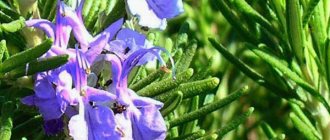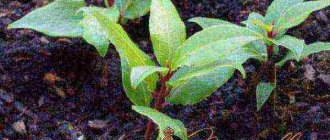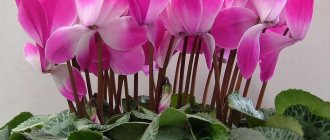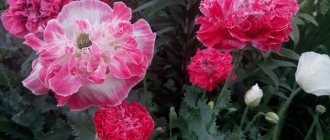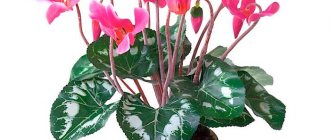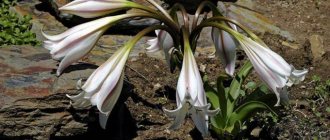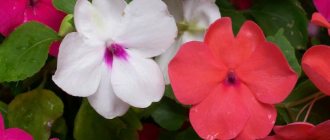Features of caring for Kos cyclamen
Watering, fertilizing, pruning and replanting a plant into a new substrate play an important role in its cultivation.
Proper care always ensures the harmonious development of any flower, which is why it is so important to know about all the possible nuances
How to water a flower
Kos cyclamen, like many of its hybrids, requires regular but dosed watering, especially during the growing season
Liquid application is usually done by immersion, and when watering from above it is important to control this process so that water does not get on the leaves and tubers
It would be more correct to pour the liquid over the edge of the pot. During the dormant period, the plants reduce the amount of moisture, but do not allow the soil to dry out.
Top dressing
During the process of active flowering and growth of the plant, it must be fed once every 2 weeks, using complex mineral fertilizer (usually the required dosage is indicated on the package). After sowing the plant (when grown from seeds), in the first 6 months, organic matter must be added along with mineral compounds.
Plant pruning
Pruning is practically not required for cyclamen Kos, but for its normal growth and development it is necessary to promptly remove faded flowers and wilted leaves, and the bases of the pedicels, which are prone to rotting, also need to be removed.
Correct transplant
Replanting cyclamen (not only Kos) should be done regularly: every year at the same time, before budding begins. Usually this time occurs in the middle of summer, when new leaves gradually begin to grow.
Do not underestimate the importance of this procedure, since within 12 months the soil in the pot is greatly depleted, which also deteriorates its structure. When replanting, you are required to completely replace the old soil mixture with a new one, with the obligatory removal of rotten and dead roots
Important! If your plant is no more than 1.5 years old, then a pot with a diameter of about 8 cm is ideal for it, while for a three-year-old plant 15 cm is ideal.
If you want your cyclamen to live for a long time and delight you with its color, it is important to prepare the right soil mixture, which is most often created from leaf soil, humus, sand and peat. You will need a little more leaf soil than the other ingredients, which are taken in equal proportions.
If you do not want to prepare the substrate yourself, then it can be purchased ready-made at any specialized store
You will need a little more leaf soil than the other ingredients, which are taken in equal proportions. If you do not want to prepare the substrate yourself, then it can be purchased ready-made at any specialized store.
Having dealt with the new soil and selected the appropriate container for the further development of your cyclamen, make small holes at the bottom of the pot and lay drainage in the form of ordinary pebbles or expanded clay, which will protect the plant from waterlogging.
When pouring new soil into a pot, there is no need to compact it, and to improve the health of the cyclamen, simply remove (unscrew) a few old leaves before placing it in a new container. The replanting procedure itself requires carefully removing the plant from the old pot and equally carefully transferring it to the new one.
The flower should be placed exactly in the center, and it should be kept suspended for some time so that the roots are not damaged. They are carefully straightened out and only after that they begin to add the rest of the soil (at first only the bottom is filled with the substrate).
To protect the plant from damage to the roots, they, along with the bulb, are taken out of the old pot, preserving the earthen lump.
Important! There is no need to cover the entire tuber with soil; it should stick out a little.
How to properly care for cyclamen
On the windowsill
On March 8th I was given a flowering cyclamen in a pot. Is it possible to plant it on the site when the weather warms up, or is it an indoor plant? How to care for it? Irina.
Natalya Anisimova, an experienced amateur gardener, answers:
– Most likely, you received Persian cyclamen (Cyclamen persicum) as a gift, various varieties of which are sold in winter and early spring in our stores. This plant does not come from Persia, as you might think, but from the Mediterranean, where it is widespread in Turkey and Greece. However, for us, summer residents of central Russia, this does not change the essence: in our open ground, these cyclamens, unfortunately, do not survive. But it is often possible to grow them as a houseplant. True, there are some difficulties lurking here too.
Cyclamen are ephemeroids, that is, they have a pronounced dormant period when they completely shed their leaves and “fall asleep.” In nature, this happens in the summer, in conditions of lack of moisture. But the period of active growth and development of plants occurs during the cold season, and in the absence of snow, cyclamens bloom in the depths of winter. Even in Mediterranean countries, the temperature during these months usually does not exceed 10–15 ˚С. And therefore, even in room conditions, plants need to be provided with the same temperature regime, which is not always possible. Cyclamens are natives of deciduous forests. They do not like direct sunlight, but they still need good lighting. The best option for them is windows with northern and eastern exposure, but it is not recommended to place them on southern and western exposures (although the situation can be saved by shading).
You need to water the plants very carefully so that water never gets on the tuber or stagnates in the pot or tray. During flowering, cyclamens will benefit from fertilizing with complex fertilizers. In anticipation of the dormant period, when the leaves begin to turn yellow and wither, watering is reduced to a minimum. But you can’t completely give up on them: even dormant plants need moisture, especially when it comes to young cyclamens with small tubers. During the rest period, the pots are placed in a shaded place at room temperature (after all, in nature, twilight reigns under the forest canopy in the summer). There is no need to put them in the refrigerator: in their homeland during these months it is not just warm, but hot!
Transplantation At the end of summer, when the “rested” cyclamens begin to grow young leaves, they are transplanted into fresh soil. The substrate is prepared from leaf soil with the addition of sand and peat (2:1:1). The diameter of the pot should only slightly exceed the size of the tuber: approximately 2–2.5 cm around the entire circumference. It is important not to forget about drainage. Since Persian cyclamens have roots located only on the underside of the tubers, they do not need to be buried. The upper part is left above the ground. In addition, when replanting, you must try to preserve the earthen ball with roots.
Cyclamen Kos. © / Photo: Natalya Zarucheyskaya
In the garden
I was on a tour in Germany, and in the park I saw a whole clearing of blooming cyclamens - small, but very cute. Do they grow here? Is it possible to buy their seeds and sow them? G. Berezhko, Smolensk
Natalya Zarucheyskaya, an experienced amateur gardener, answers:
– In the large family of cyclamen, in addition to the Persian one, known as a houseplant, there are several more species that grow successfully in gardens. They are very popular throughout Europe (even to Scandinavia), but, unfortunately, they are still rare in our summer cottages. But these beautiful plants will happily settle with us.
Important! Cyclamen Kos and some of its subspecies are found in the wild in the southern regions of Russia, in the Crimea and the Caucasus. These are rare plants listed in the Red Book. Collecting and digging them in nature is strictly prohibited! Also, you should not encourage poachers who sell bouquets of wild cyclamen flowers in the spring.
In European countries with their almost snowless winters, cyclamens bloom in December–February. In our country, different species behave differently: there are spring-flowering (March–April) and autumn-flowering (August–October).
In the Moscow region, the most promising garden varieties are European cyclamen (autumn-blooming) and c. Kossky (spring flowering). In the Kaliningrad region and other areas with milder winters, c. ivy-leaved (also called Neapolitan). Tubers of all these species and their cultivars, differing in flower colors and leaf patterns, can be found for sale at garden centers or from collectors.
Photo: Natalya Zarucheyskaya
It is better to plant cyclamen in slightly elevated places that are not flooded by melt water. This also applies to flooding under snow in warm winters. It is better to choose a semi-shaded place - these are forest plants. Before planting, you need to add humus, coarse sand and some fine crushed limestone to the soil. It is important to ensure good drainage. The tubers are planted shallow: their upper part should be at or just below the soil surface.
In the spring, it is useful to add humus under the cyclamens, and in the winter, lightly cover them with dry leaves or pine litter (with a layer of about 5 cm). In spring, most of the shelters are removed.
Despite. Although cyclamen often self-sow in the garden, it is quite rare to grow them from purchased seeds. Only freshly harvested seeds have good germination. They germinate best at a temperature of 13–15 °C, constant humidity and always in a dark place. Young plants bloom in the third year.
This is interesting. European cyclamen was formerly widely known as “alpine violet”. This is the only cyclamen that can grow in our climate, the flowers of which have a strong aroma. It is also unusual in its reproduction: the tuber produces “babies” in the shape of fingers, by planting which you can get new plants.
aif.ru
zakustom.com
How to plant?
Decorative cyclamen can be purchased at any flower shop. In this case, the plant can be left in store soil for some period. In the future, it needs to be completely changed or brought to the proper form gradually. To achieve the second, it is necessary to regularly, but not in large quantities, feed the flower with various fertilizers of natural origin and add a small amount of new soil taken from the wild area. The procedure for “refining” store-bought soil is carried out in several stages so as not to shock the plant.
Planting wild cyclamen. Unlike a decorative flower, wild cyclamen takes root well both in the garden and in a flower pot. Its tubers can be dug up in the forest. It is worth remembering that it is included in the Red Book, and large-scale harvesting of seedlings can be regarded as a violation of established legislation. To breed Kos Cyclamen at home, it is enough to have only a few tubers. Moreover, they can take root not only in their entirety, but also in their partial form.
During these months, a slowdown in the activity of metabolic processes is observed in the cellular structure of the plant. A kind of sleep sets in, which brings the flower into a state of readiness for transplantation.
You need to dig up the tubers with caution, trying not to damage the roots. The latter are located in the center of the lower side of the tuber and can go into the ground at a distance of up to 10 cm
Using a garden trowel, make vertical cuts in the soil around the bush. The distance from the expected center of the root system to the cuts should be from 10 to 15 cm.
The tuber system, along with the stems coming from it, must be removed from the soil
When removing a clod of earth, it is important not to tear off a significant part of the roots. After extraction, the soil can be carefully removed from the tubers
There can be from 2 to 3 of them in one bush. There are bushes containing 5 tubers or one large one.
The best conditions for plant survival will be created by the soil in which it grew before. It is necessary to collect a small amount of it. The volume of collected soil is determined by the location where the plant will be transplanted. If its future place is in a flower pot, then the volume of soil will be equal to the internal volume of the pot, plus one third (for further filling). In the case when a flower is planted outdoors, there is no need to prepare a lot of soil. A sufficient quantity will be enough to fill the hole in which the tuber will be placed.
Whole tubers take root best. However, for propagation purposes, each tuber can be divided into several parts.
This must be done with caution. If divided incorrectly, some parts may be unusable
In order to avoid such excesses, you need to cut the root vegetable into 4 parts with a sharp knife, drawing perpendicular cut lines through the center. At the same time, make sure that there are enough roots left on each part.
Planting is carried out as follows: dig a hole 5-8 cm deep in the right place. Place the tuber or part of it there. Pour a small amount of water and bury without compacting. Loose soil above the tubers is important to ensure the delivery of oxygen, which the plant needs most when a stressful situation occurs.
Cyclamen does not like to grow at the peak of elevation. Such a place quickly loses moisture, which negatively affects further growth and the formation of the entire root system. If it is placed in a low area, this can also negatively affect further growth. Moisture accumulates in the recess, which contributes to the rotting of the transplanted tuber.
Cyclamen coum. Care at home.
Details Created 01/03/2013 19:49
Cyclamen coum. Care at home.
Description. Cyclamen coum is one of those few beautiful plants that bloom in winter or early spring.
Its foliage begins to appear in late autumn or early winter. The glossy foliage varies in color from dark green to almost silver depending on the variety. The color of the flowers varies: white, pink, red, purple, but always with a brightly colored base of the petals. Synonyms: Cyclamen hiemale, Cyclamen kuznezovii, Cyclamen vernum. This very variable species of Kos cyclamen (Cyclamen coum) is characterized by a tuber with roots growing only from below, and the limb of the petal, sharply expanded from the base, where there is a dark spot. Certain patterns are observed in the changes in the color of the petals, the size of the flowers and the shape of the leaves: kidney-shaped leaves and pale pink flowers in plants from southern Turkey and Syria, bright pink ones on the Black Sea coast of Turkey, further to the east the flowers become larger and the leaves narrower. Finally, the largest flowers and narrow heart-shaped leaves are found in plants from the shores of the Caspian Sea in southern Azerbaijan and Iran. Homeland. Cyclamen coum, named after the island of Kos in the Aegean Sea, located next to Turkey. It grows in the mountainous and coastal regions that border the southern and eastern Black Sea from Bulgaria in the west and through Georgia and Crimea in the east of the country. Cyclamen coum can also be found in the Elbrus mountains in northern Iran, southern Turkey, along the eastern coast of the Mediterranean through Syria and Lebanon to Israel. Location. Cyclamen coum prefers partial shade. Substrate. For Kos cyclamen (Cyclamen coum) prepare a rich but well-drained substrate. Reproduction. Cyclamen coum is propagated by seeds and by dividing the tuber. Before sowing, the seeds are soaked for 12 hours. Sow seeds in late spring for flowering next year. When growing Kos cyclamen (Cyclamen coum) in the garden (but not in our Siberian regions), its seeds are spread throughout the garden by ants, as they have a sweetish shell. Pests. Spider mites and cyclamen mites are dangerous for Kos cyclamen (Cyclamen coum). Diseases. Of the diseases, cyclamen Kos (Cyclamen coum) most often affects gray mold. Varieties. In 1997, Gray-Wilson described three subspecies of Kos cyclamen: Cyclamen Kos various. Cos - Cyclamen coum subsp. Coum has rounded leaves, petals from 0.8 to 1.4cm with white, sometimes very pale pink "eyes"; leaves are heart-shaped, wider, petals 1.2 – 2.5cm long, with pale, deep “eyes” pink, less often white. The flowers are pink to purple, with dark markings at the base of each petal lobe. Flowers appear over a long period from December to April, typically pale pink to dark purple with a crimson or purple spot at the base of each petal. Grows in Bulgaria, along the western Black Sea coast of Turkey, Syria, Lebanon and Israel. Cyclamen Kos various. Elegant – Cyclamen coum subsp. Elegans: leaf blade usually shallowly lobed, roughly toothed; petal 1.8 - 2.5 cm long. Cyclamen Kos variety. Caucasian – Cyclamen coum subsp. Caucasicum: leaf blades are not lobed, although often slightly toothed or scalloped; petal 1.2 - 2 cm. Lives in the eastern part of the Black Sea coast of Turkey, Georgia, the Caucasus, Crimea and Northern Iran. It grows at an altitude of 2000 m above sea level. Cyclamen Kos variety. Kosskiy can withstand extremely low temperatures. Cyclamen Kos various. Caucasian is less resistant to extreme temperatures. It will grow well in both shady locations and hotter climates. However, if the plant is grown indoors, it needs to be provided with a well-drained substrate.
Cyclamen varieties for growing in the garden
In addition to the Persian and European cyclamen, Kossky cyclamen and the Kuznetsov species cyclamen are also suitable for growing in open ground.
Cyclamen persica
This is a perennial tuber-root herbaceous plant, reaching a height of 30 cm. Its basal leathery leaves are dark green in color. On the Persian cyclamen tuber there is only one growth point, damage to which will lead to the death of the plant. Persian cyclamen flowers come in a variety of colors: white, pink, crimson, purple, violet and even burgundy. Some varieties of Persian cyclamen have a sharp and even slightly intrusive, but very pleasant smell. Flowers, as I already said, can be pink, crimson, white, lilac.
European cyclamen
European cyclamen (or Neapolitan, or ivy-leaved), or, as it is also called, ivy-leaved, whose homeland is the Crimea and the countries of Southern Europe, is a small herbaceous evergreen tuberous plant. Its leaves have a rounded kidney shape and a heart-shaped base. The tuber of European cyclamen, which has small roots all over its surface, is more spherical and slightly elongated, and can reach up to 10 cm in diameter. The flowers of European cyclamen are relatively small, distinguished by a strong pleasant aroma and a delicate lilac-pinkish color.
Cyclamen Kos
One of those few beautiful plants that bloom in winter or early spring. Its glossy foliage varies in color from dark green to almost silver depending on the variety. The color of the flowers varies: white, pink, red, purple, but always with a brightly colored base of the petals.
Cyclamen Kuznetsova
Cyclamen Kuznetsov is a local endemic, its distribution is limited to a very small area in Crimea between Belogorsk and Stary Krym. This is a medium-sized (up to 10-15 cm in height) plant with a fleshy, round, flattened tuber. The leaves are round, dark green, often with a whitish pattern, and purple-colored on the underside. The flowers are solitary, pink, very rarely white, fragrant. Kuznetsov's cyclamens bloom at the end of February, when the plants are still partially under the snow. The corolla consists of 5 petals fused at the base. An unopened bud on an elegant thin peduncle somewhat resembles the outline of one of the most beautiful birds - a swan. Cyclamen is promising for cultivation and reproduces well by seeds. Kuznetsov’s beautiful and healing cyclamen was rapaciously destroyed by bouquet collectors for many years, and was also dug up for individual cultivation and to obtain medicinal raw materials.
Where to buy cyclamen tubers
Cyclamen belongs to the Primulaceae family. In total, there are more than 20 varieties of such perennial plants with tuberous roots. Distributed in the Mediterranean, Northeast Africa, Iran. It is often found in the wild in Turkey.
Certain species have been planted for a long period, both in gardens and in apartments. There are two types of cyclamen intended for indoor cultivation. Namely: Persian and European.
European cyclamen is called "Alpine violet". Throughout the year it feels great on the windowsills in the apartment, provided the temperature is maintained at +18...+20 °C. Not tied to a specific humidity level. Blooms profusely from spring to autumn. Compared to Persian cyclamen, this plant is not often found in flower shops. The latter refers to the parent species for many modern hybrids.
Today's cyclamens differ from wild varieties in the size of their flowers. Compared to their predecessors, they are larger. The color can be snow-white, pink, scarlet, dark purple. Hybrids with multi-colored and corrugated petals have gained enormous popularity. In recent years, there has been a demand for mini-hybrids in Europe. They are small bushes with large flowers. This type of cyclamens can be grown in garden conditions and in places where there is a cool climate.
Modern floriculture, depending on the size of plants and flowers, classifies cyclamens into 3 groups.
Mini cyclamens. These include: “Silverheart”, “Midori”, “Zhanetto”, “Libretto”, “Silverado”. Such plants are distinguished by large flowers. As a rule, they exceed 4 cm. In this group you can often find aromatic cultivars. Pots with a diameter of 6-10 cm are suitable for growing.
Midi-cyclamens. These include: “Kanto”, “Laser”, “Sterling” and others. They have a medium socket size. Planted in pots with a diameter of 10–13 cm.
Maxi-cyclamens (standard or large-flowered): “Concerto”, “Rainier”, “Sierra”, “Winter Ice” series. The size of the growing pots is 13-20 cm in diameter.
Cyclamen goes on sale in the first months of autumn. The plant is especially loved because it pleases with its long flowering in winter. With the onset of spring, cyclamen stops blooming. It loses its leaves, and this is where many gardeners make a mistake—they throw away the plant because they think it is gone. If you provide the cyclamen with proper care, it will bloom actively for many years.
What does Lesnaya cyclamen look like and what family does it belong to?
The flower belongs to the ornamental plants. Indeed, its flowering is so spectacular that it can become a decoration of any place where it grows.
Cyclamen Forest
Cyclamen is a herbaceous perennial plant. It comes from the Primulaceae family of the Myrsinaceae subfamily. It is distinguished from its relatives by its small inflorescences. The color of the flowers is pink, lilac, red with dark spots that look like eyes. The homeland of the alpine violet is considered to be Asia Minor, the Mediterranean, and northeast Africa.
This flower was first discovered in Israel on mountain peaks covered with snow. In the 17th century he ended up in Europe. It began to be grown in English houses in pots. At that time, cyclamen was still considered wild, but its popularity began to grow. Since then, breeders have developed many different varieties of this wonderful plant.
Diseases and pests of succulents
Beautiful, undemanding plants have earned popularity due to their whimsical shapes and ease of care. But they can get sick from improper care, damage by insects or fungi, or rot.
Therefore it is necessary:
- observe the watering and feeding regime;
- Provide the bottom of the planting hole with a drainage mixture;
- there should be a hole at the bottom of the vase;
- propagate vegetatively in spring and summer, keeping the cuttings in the air for several days before planting, thereby protecting against the penetration of parasites into the cut.
The distribution of succulents in gardens and parks is justified. The originality and uniqueness of the natural creation create a good mood, ennobling the area. The main thing is to choose the right types of plants and provide them with proper care.
How to replant?
A transplant is not always necessary. It is recommended to carry it out after purchasing a new flower. In a flower shop, it grows in a special substrate so that there are no problems when transporting it from abroad. In the future, it interferes with the good flowering and growth of the plant.
When the tuber grows greatly and it becomes obvious that the plant is cramped in the pot, it is important to replant it. If you delay, the roots will grow too much and they will not have enough nutrition to meet all their needs.
Alpine violet is replanted because there is a need to change the substrate. Over time, the soil in the pot becomes depleted, even with good feeding. In addition, it is an excellent environment for the development of parasites, the proliferation of fungi and bacteria.
If desired, every gardener can cope with a cyclamen transplant. You don’t have to do anything special, the main thing is to strictly follow the steps listed below:
- Preparing the drainage layer in the pot. To do this, simple pebbles or expanded clay are placed on its bottom in a layer of 1.5-2 cm. An improperly formed drainage system is a common cause of stagnation of water in the soil.
- Preparing soil from leaf soil, turf, sand and pine needles. It is poured out so that it is not level with the sides of the pot, but slightly lower. Under no circumstances should it be compacted.
- Removing cyclamen from an old pot. Its roots are cleared of the earthen clod, but not completely. The tuber is not ignored. All dry and rotten roots are removed using a sharp knife or nail scissors.
- Placing the tuber in the center of the new pot (read about the healing properties of the cyclamen tuber, as well as how to plant and care for it here).
- Carefully straighten all the roots.
- Cover the roots with prepared slightly moistened soil.
- Watering a transplanted alpine violet.
Important! When transplanting cyclamen from one pot to another, be careful not to damage the fragile roots. If injury occurs, the bulb will not take root.
The cyclamen will get sick and die.
How to plant cyclamen in open ground?
When planting cyclamen tubers in the ground, the following planting rules should be taken into account:
- The tubers of the plant are placed in a hole with a pre-prepared soil mixture, deepening them 10 cm into the soil. This is the optimal planting depth for cyclamen, which will not allow the flower to freeze in winter.
- When planting a tuber, special care should be taken not to damage it. The cyclamen tuber has only one growing point. A damaged tuber will not grow and the plant will die.
- When planting, it is worth considering that cyclamen grow excellently in a well-chosen permanent place for up to 10 years. Frequent replanting is unfavorable for the plant, as it weakens its root system.
Is it possible to plant cyclamen outside?
Many people wonder, when planning to grow cyclamen, whether this flower can be planted in open ground. In Russia, it is not often possible to find cyclamen in a flower bed, since the flower is considered primarily an indoor plant. But, despite this, growing this flower in a flower bed is quite feasible, even with wintering.
Garden frost-resistant
Garden cyclamen blooms from early spring to late autumn, that is, almost all summer, it pleases with its unique attractive appearance. The plants differ in that they tolerate frost well. The plants are distinguished by juicy and durable tubers, which are located near the soil surface. The main advantage of frost-resistant garden cyclamen is its unsurpassed aroma, which will delight the gardener for a long time.
Cyclamen Elegans
Ivy-leaved cyclamen: planting and care in open ground
One of the most charming varieties is the ivy-leaved cyclamen. This flower is distinguished by excellent frost-resistant properties and delicate flowers. You can plant such cyclamens on the street or in the house.
Regardless of where it grows, the flower does not need any special care. It is enough to properly prepare the soil and water it in a timely manner, systematically feed it, remove faded flowers, and also treat it with acaricides several times.
How to grow cyclamen in your garden?
So, cyclamen is a bulbous perennial, ornamental plant that grows in open ground in a warm climate zone, decorating the landscapes of the Crimean coast, as well as the shores of the Mediterranean, Black and Caspian Seas.
- Place for planting in the garden. Heat-loving and demanding of sunlight, the cyclamen plant is planted in shaded areas of the garden. Direct sunlight can burn young leaves, so choosing sunny places for planting is not entirely correct. Cyclamen will develop much better in the shade of fruit trees and shrubs, where the sun's rays appear occasionally, breaking through the foliage, and the heat is retained. The landing site must be protected from possible gusts of wind and light drafts.
- Air temperature. Warmth is warm, but the cyclamen flower does not like summer heat. The optimal growth temperature can be considered 17-20 degrees Celsius. If the indicators are significantly exceeded, the plant will simply shed all its foliage and shorten the flowering period.
- The soil. For planting cyclamen, garden soil is suitable, consisting of rotted leaves and turf, mixed with crushed limestone or expanded clay gravel, which serves as good drainage for the root system of the plant.
- How to plant a bulb correctly. The rhizome of cyclamen resembles a rather large onion, round in shape, with a smooth surface and a diameter of up to 15 centimeters. Before planting the bulb in the ground, you need to dig a hole, water it with warm, settled water and then bury the cyclamen bulb completely in a moistened soil mixture treated with a fungicide solution. It is necessary to bury the bulb, since in winter it can freeze, being partially on the surface of the soil. Leave a third of the rhizome on the surface of the soil when planting cyclamen as a houseplant. If the bulb remains open, it can have a positive effect on the flowering period. When planting a bulb, the main point will be the condition of the growth point, because with the slightest damage or falling asleep with soil, there is a possibility that the plant will not only stop growing and reproducing, but may even die. The bulb should be placed in the ground with its growth buds facing upward. Different varieties may have different numbers of flower sprouts. Some flower rosettes have several, while others have only one growing point and this is worth paying special attention to when transplanting bulbs.
- When to replant, recommended timing. Cyclamen bulbs are ready for transplantation at the moment when sprouts begin to come to life and sprout after a period of rest or “hibernation”. The ivy-leaved cyclamen Neapolitan blooms in late summer and the bulb is planted in May. Cyclamen Kossky will already bloom in April next year, so its bulbs are planted in September. Seeds of Persian and European cyclamen are sown in February, and tubers are replanted at the end of September.
- Uniformity of watering. It should be noted that cyclamen dies when the soil is over-moistened, but the plant does not develop even during drought. Watering should be uniform and standardized to avoid both drying out the soil and overflowing. Remember, it is strictly forbidden to irrigate the leaves. Water getting inside a leaf rosette can kill the entire plant. Pots with planted tubers for germination during watering are placed on a tray filled with water. In the garden bed, cyclamens are watered at the root after the top layer of soil has dried.
- Removing flowers and leaves. Faded and withered flower buds, yellowed and dried leaves must be removed in a timely manner. Flowers are cut off or picked, but the leaves must be “twisted”, trying not to damage the growth part of the tuber.
- Feeding. Considering the rather long process of germination of both tubers and seeds in a specially prepared and nutrient-rich substrate, the first fertilizing is carried out 30 days after planting the seedlings in open ground. Repeat feeding at intervals of one month throughout the entire growing season. In winter, feeding is stopped. The plant is grateful for the application of liquid organic fertilizers, diluted chicken droppings or rotted manure.
- Winter shelter. Even when growing cyclamen in the southern gardens of Crimea, the need to build a winter shelter is present. Fallen leaves, sawdust, and various mulches will not only protect cyclamen tubers from frost, but will also serve as an excellent feed after the plant awakens and will keep the top layer of soil moist.
- Pests. Cyclamens, like any garden plants, are susceptible to fungal diseases and insect pests. Aphids, fleas, ants, and spider mites easily settle in flowering garden beds. No traditional methods of control will have the expected effect on the pest; rather, they will destroy the plant itself. Only the use of insecticides will be the only way to combat various mites and aphids.
Reproduction of garden cyclamens
The most common method of propagating cyclamen can be called tuberous, that is, separating part of the tuber with the resulting growth point. This is how autumn flowering plants are propagated, since the seeds do not have time to reach their technical maturity and will not produce new shoots. But, for example, “Persian cyclamen” can increase its plantings solely through seed propagation. The thing is that its tuber is completely impossible to separate and the usual method is not relevant here. Another thing is “European cyclamen”; it can adapt and actively increase the population both after dividing the bulb and after planting the seeds. It should be noted that these beautiful plants, regardless of color or type, can successfully grow without changing their permanent location for not a year or two, but up to ten. On the contrary, experts are confident that with frequent division of the bulb, cyclamen weakens significantly, losing its former charm and beauty, so there is no need to take risks, it is better to contemplate the beautiful flowering. Conclusion, if you want to achieve lush, gorgeous flowering, you don’t need to plant cyclamen bulbs too often.
Cyclamen pests
During the cultivation of cyclamen, both Persian and European, I did not encounter most of the problems that are written about in specialized publications: rotting of leaves, falling ovaries, etc., which can be avoided by properly caring for the plant. Therefore, I will not tell you about them, I will only say that once I had to watch how the leaves of my European cyclamen were crushed and deformed. Having sifted through many articles about growing cyclamen and the rules for caring for it, I found out the reason for such an unfortunate phenomenon; it turned out to be the cyclamen mite. To combat the pest, I washed the leaves of the plant with insecticidal soap every week for 5 days, after which I sprayed them with a special insecticidal preparation “Agravertin”. By the way, this same treatment method will help you cope with aphids, which also love to settle on cyclamen plants.
Caring for a “dormant” plant
As we have already said, the flower spends most of the year in hibernation. Cyclamen usually survives the dormant period well. There is practically no need to care for it; it is enough to water it occasionally, not allowing the top layer of soil to dry out. Indoor cyclamens can be moved to a cool, dark place with moist air.
For garden varieties, the wintering period is very important. However, there is no need to specially insulate cyclamens. If they grow under your trees, then a layer of fallen leaves will be enough. Under such a thick natural blanket, the beauties will have a great time waiting out the cold.
Description
The beautiful carpet that blooms next to the trees is made up of primrose bulbs, as well as other flowers that tend to spread out. With the arrival of spring and late autumn, its pristine beauty and unique gardens will delight you.
They are quite resistant to frost, and are also similar to flowers in gardens, covered in the shade of elevated bushes and trees, as if glistening with a ruddy glimmer of pleasure. So, on depleted soil of fallen fiery leaves, small flowers on leaves with a thin peduncle on top look like an unusual Mirage.
Garden cyclamens show their excellent appearance from spring until the end of autumn. It is difficult to care for the large-flowered species, as they are afraid of dampness, deprived of the unique superiority of medium-sized cyclamens.
So, this flower is winter-resistant. It can complement any room or garden area.
Sometimes you can hear it. What is this plant called - dry wood.
The tubers of such flowers are massive and dense, located close to the ground. Garden cyclamens are characterized by an intense and massive tuber located almost on the surface layer of soil.
Leaves and stems are formed from rounded tubers; each stem is crowned with only one bud
Beautiful round autumn leaves, the bluish tint accentuates the beauty. The flowers have intense colors, which are quite varied.
The leaves have a gray tint. Most cyclamens have pink buds, but beige ones also exist. So, when growing garden cyclamen on your site, you need to remember that such a plant is poisonous. However, the poison is not dangerous for humans.
The advantage of cyclamen is its aroma, which is reminiscent of lily of the valley. Its flower stalks do not wither, but begin to twist into a spiral. If the material for planting was purchased in a store, then it is worth clarifying its genetics. Thus, it is recommended to buy the material that is suitable for your climate.
Types of cyclamens
- Summer alpine violet. It has a purple color, the flowering period falls in July.
- Autumn alpine violet. The sheets have a silver pattern. Flowering begins in autumn. It freezes out in winter, but with the arrival of warmth it is renewed by self-seeding. That is why hybrid varieties appear. The leaves of these species are unusual: with drawings, openwork edges.
Garden cyclamen - loves shaded places where there are no drafts.
Growing
Planting garden cyclamen
This color is growing. To quickly plant alpine violets, you should use the seed method. For this purpose, you will need a container, then you should pour soil into the container, level and spread the seeds, then you will need to fill it with soil (1 cm).
Move the container to a warm place (at least 18 C). Irrigate the seeds using a watering can or by spraying. As soon as the leaves are formed, they must be transplanted into a new pot. They grow both in shaded places and on rocky areas.
Such flowers look unusual when planted in large numbers. So, they can be combined with both ivy and snowdrops. So, garden cyclamen can be used to decorate hedges and small hills. As a rule, they are planted near coniferous plants.
Without a doubt, it is used for decoration purposes. They can decorate balconies, verandas, terraces. But as soon as the temperature drops to 0C, they are moved to a warmer place.
Planting garden cyclamen
Garden cyclamens gradually grow, multiplying independently and forming colorful clearings. But this, of course, takes time. The easiest way to “quickly” increase your alpine violet planting is to grow new plants from seeds. To do this, pour nutritious soil for seedlings into any container or pot, level it, scatter the seeds over it in a thin layer and cover the top with soil no thicker than 1 cm. Place the box or pot with seeds in a room so that the ripening temperature is stable - about 18 ° C . Water the seeds from a watering can with a sprayer. After the shoots appear, wait until the first pair of leaves have fully developed, and then plant each plant in a separate container.
Cyclamen grow both in the shade of bushes and trees, and among large stones in rockeries. Garden cyclamens can also be used on classic rocky hills. Cyclamens look best when planted in large masses, especially if combined with protruding roots of large trees and stones. Of plants similar in growth form, cyclamens can be planted with colchicums, snowdrops and crocuses; They also look good with primrose species that are not prone to taking over space. They go well with ivy, gentians and godsons. All types of cyclamen can be grown as a potted crop.
To decorate the garden, you can use not only cyclamens growing in open ground, but also large-flowered “indoor” varieties of Cyclamen Persianis, which love cold air. They can be placed in sheltered areas of the terrace and balcony at the end of summer and left there until the temperature drops to zero.
Features of growing cyclamen
Different types and varieties of cyclamen delight the whole season. Already from a distance, the delicate pink-red shimmer under the trees catches the eye. Taking a closer look, we will find many small flowers almost close to the ground, one at a time on thin peduncles, with petals provocatively sticking up.
Content:
The plant itself is well known, since the large-flowered relatives of these winter-hardy flowers - cyclamens (in Germany they are also called alpine violets, and in Russia dryakova) have long made a career as indoor plants. It’s just that they lack the unsurpassed charm of little savages.
Cyclamen likes a sheltered place. Cyclamen has thick, juicy, brown underground tubers. They are located directly underground, contain a lot of starch and become larger over the years.
Varieties of cyclamen
Several wild species of cyclamen are found in Europe. Unfortunately, this plant, belonging to the primrose family, has become rare in nature. So, if climatic conditions permit, it is worth allocating a place for it in the garden. Best protected from winds, in partial shade. The soil should be rich in humus and contain lime.
Indoor varieties of cyclamen are also suitable for decorating a terrace or balcony at the end of summer and autumn.
Purple cyclamen, or summer alpine violet, blooms from July to September. It differs from the ivy-leaved cyclamen (Neapolitan) or the autumn alpine violet in its arrow-shaped leaves with a silvery pattern.
- Scarlet Moth - bright scarlet flowers that resemble a flock of flying butterflies
- Spring moth - pink, light lilac, medium-sized flowers, flowering time - early
- Apple - white and pink with a dark eye, the leaves have marbled decorative patterns, is the slowest growing variety of cyclamen
- Victoria - large velvet flowers of soft pink color
- Vit - white large cyclamens
- Violet Cattleya - bright lilac flowers
- Carousel crimson - large cyclamens with cup-shaped leaves
- Darts Salmon pink - have early flowering, less whimsical than other varieties
- Lakhsharlah - large peach blossoms
- Madina - a small cherry blossom plant
- Pink moth - Neapolitan cyclamens
It is best to water cyclamens from above with water that has been infused for 24 hours; under no circumstances should you overwater the plant.
Where to plant cyclamen?
Different types and varieties of cyclamen delight the whole season. Flower-strewn carpets grow in front of hedges and under bushes. Rose-red and sometimes white flowers spread a wonderful lily-of-the-valley scent around. The perfect decoration for gloomy winter days in areas with mild winters is Cyclamen Kos, whose carmine-red flowers open as early as February. It should be planted in September closer to the house in order to enjoy its wonderful beauty when looking out the window.
Several wild species of cyclamen are found in Europe. The soil should be rich in humus and contain lime.
Indoor varieties of cyclamen are also suitable for decorating a terrace or balcony in late summer and autumn.
Growing cyclamen in the country (video)
Cyclamen seeds should be planted in already prepared earthen mixture to a depth of no more than 1 centimeter. You can also use peat cups when planting. First, make a groove, fill it with water, place the seeds, and later cover it back with earth. The glass should be closed with a lid: this is done to achieve the optimal seed germination temperature - 19 degrees Celsius. After about 35 days, you will see the first shoots, but if cyclamen does not appear within this period, do not despair, because its seeds can germinate within 60 days (for example, the Apple variety).
It is worth allocating a place for it in the garden, best protected from the winds, in partial shade.
Video: planting and caring for cyclamen
Reproduction
Persian cyclamen should be propagated using seeds. Planting is done in late February or early March, this will be the most convenient time for planting, but you can also sow seeds at any other time of the year. Before planting, be sure to treat the seeds with potassium permanganate or special preparations. Soaking is mandatory when planting this type of flower; this is done to accelerate the growth of cyclamens.
Cyclamen loves a sheltered place. Cyclamen has thick, juicy, brown underground tubers.
Transplanting flowers
It is necessary to remove the cyclamen from the old form or from the flowerbed, remove small roots and old soil. You need to save the main part of the roots of the cyclamen - this will help it better take root in the new place. A prerequisite for replanting is the presence of drainage for flowers. Place a small layer of soil on the drainage, but do not compact it. Now you can water the ground and then fill the flower so that a third of the tuber remains in the air. Leave the plant in the shade and after a while new leaves will appear.
In Germany they are also called alpine violets, and in Russia dryakova
Cyclamen care
Watering the plant
It is best to water cyclamens from above with water that has been steeped for 24 hours; under no circumstances should you overwater the plant: water should not get on the inflorescences, leaves and buds, this can destroy the entire plant.
Top dressing
You should not overfeed the plant - it is better, on the contrary, to feed it in slightly smaller quantities than required. You should not feed young plants; it is better to feed adult cyclamens. Also, you should not create an excess of mineral fertilizers in the soil. Do not add manure to the soil mixture - the plant may rot.
Gallery: cyclamen (25 photos)
In order not to lose the material, be sure to save it to your social network VKontakte, Odnoklassniki, Facebook by simply clicking on the button below:
dachadecor.ru


